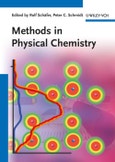Thanks to the progress made in instruments and techniques, the methods in physical chemistry have developed rapidly over the past
few decades, making them increasingly valuable for scientists of many disciplines.
These two must-have volumes meet the needs of the scientific community for a thorough overview of all the important methods currently
used. As such, this work bridges the gap between standard textbooks and review articles, covering a large number of methods, as well as the
motivation behind their use.
A uniform approach is adopted throughout both volumes, while the critical comparison of the advantages and disadvantages of each method
makes this a valuable reference for physical chemists and other scientists working with these techniques.
few decades, making them increasingly valuable for scientists of many disciplines.
These two must-have volumes meet the needs of the scientific community for a thorough overview of all the important methods currently
used. As such, this work bridges the gap between standard textbooks and review articles, covering a large number of methods, as well as the
motivation behind their use.
A uniform approach is adopted throughout both volumes, while the critical comparison of the advantages and disadvantages of each method
makes this a valuable reference for physical chemists and other scientists working with these techniques.
Table of Contents
Volume 1PART I: Gas Phase
MANIPULATING THE MOTION OF COMPLEX MOLECULES: DEFLECTION, FOCUSING, AND DECELERATION OF MOLECULAR BEAMS FOR QUANTUM-STATE ANDCONFORMER SELECTION
Introduction: Controlled Molecules
Experimental Methods
Experimental Details
Selected Applications
Conclusions and Perspectives
LASER IONIZATION SPECTROSCOPY
Introduction
Basic Principles
Experimental Methods
Case Studies
Conclusions and Perspectives
Supplementary Material
MASS SPECTROMETRY FOR ION CHEMISTRY AND LINKS FROM THE GAS PHASE TO 'REAL' PROCESSES
Introduction
Key Experimental Methods
Ion Structures
Ion Energetics
Reactions of Neutral Molecules Studied by Mass Spectrometry
Ion Catalysis
Summary and Perspectives
PART II: Condensed-Phase
SOLID STATE NMR: A VERSATILE TOOL IN SOLID STATE CHEMISTRY AND MATERIALS SCIENCE
Introduction
Basic Principles
Experimental Techniques
Selected Applications
Conclusion
Supplementary Material
EPR -
ESR -
EMR, AN ONGOING SUCCESS STORY
Introduction
Basic Principles
Experimental Methods
Case Studies
Conclusions and Perspectives
Supplementary Material
BROADBAND CONDUCTIVITY SPECTROSCOPY FOR STUDYING THE DYNAMICS OF MOBILE IONS IN MATERIALS WITH DISORDERED STRUCTURES
Introduction: 'Microscopy in Time' in Disordered Ionic Materials
Experimental Techniques: Spanning More Than 17 Decades in Frequency
Linear Response Theory: Current Density and Conductivity
Conductivity Spectra: Universal Properties Detected
'First' Universality: Spectra and Modeling
'Second' Universality: Spectra and Modeling
X-RAY ABSORPTION SPECTROSCOPY - THE METHOD AND ITS APPLICATIONS
Introduction
Basic Principles - the EXAFS Equation
Experimental Methods
Case Studies
Conclusion
DIFFRACTION METHODS: STRUCTURE DETERMINATION AND PHASE ANALYSIS OF SOLIDS
Introduction: Diffraction -
What for?
Basic Principles of the Elastic Interaction of Radiation and Periodic Arrays of Atoms
Methods and Their Applications
Summary: Diffractometry-Where To?
SMALL-ANGLE X-RAY AND NEUTRON SCATTERING -
TWO COMPLEMENTARY METHODS TO STUDY SOFT MATTER STRUCTURE
Introduction
Basic Theory of Small-Angle Scattering
X-Rays and Neutrons
Selected Applications
Conclusions
PERTURBED GAMMA TO GAMMA ANGULAR CORRELATION
Introduction
Basic Principles
Case Studies
Conclusions and Perspectives
MÃSSBAUER SPECTROSCOPY
Introduction
Basic Principles
Experimental Methods
Case Studies and Selected Applications
Outlook
ELECTRON ENERGY LOSS SPECTROSCOPY AS AN EXPERIMENTAL PROBE FOR THE CRYSTAL STRUCTURE AND ELECTRONIC SITUATION OF SOLIDS
Introduction
Basics of EELS
Selected Applications of EELS
Outlook
Volume 2
PART III: Interfaces
RAMAN SPECTROSCOPY: PRINCIPLES, BENEFITS, AND APPLICATIONS
Introduction
Basic Principles: Raman Scattering
Experimental Methods
Applications of Raman Spectroscopy
Conclusion
DIFFUSE REFLECTANCE INFRARED FOURIER TRANSFORM SPECTROSCOPY: AN IN SITU METHOD FOR THE STUDY OF THE NATURE AND DYNAMICS OF SURFACE INTERMEDIATES
Introduction
Basic Principles
Experimental Set-Up
Application Examples
Summary
PHOTOELECTRON SPECTROSCOPY IN MATERIALS SCIENCE AND PHYSICAL CHEMISTRY: ANALYSIS OF COMPOSITION, CHEMICAL BONDING, AND ELECTRONIC STRUCTURE OF SURFACES AND INTERFACES
Introduction
Experimental Procedure
Case Studies: XPS
Case Studies: UPS
Conclusions and Perspectives
Supplementary Material
PHOTOELECTRON MICROSCOPY: IMAGING TOOLS FOR THE STUDY OF SURFACE REACTIONS WITH TEMPORAL AND SPATIAL RESOLUTION
Introduction
Basic Principles: Photoelectron-Based Analytical Techniques
Experimental Methods
Case Studies (Selected Applications)
Conclusions and Perspectives
Supplementary Material
SECONDARY ION MASS SPECTROMETRY -
A POWERFUL TOOL FOR STUDYING ELEMENTAL DISTRIBUTIONS OVER VARIOUS LENGTH SCALES
Introduction
Basic Principles
Experimental Methods
Case Studies
Conclusions and Perspectives
Supplementary Material
APPLICATION OF THE QUARTZ MICROBALANCE IN ELECTROCHEMISTRY
Introduction
Basic Principles
Experimental Methods
Case Studies
Conclusions and Perspectives
Supplementary Material
THE SCANNING TUNNELING MICROSCOPE IN ELECTROCHEMISTRY: AN ATOMISTIC VIEW OF ELECTROCHEMISTRY
Introduction
Basic Principles
Experimental Methods
Case Studies
Conclusion and Perspectives
Supplementary Material
LOW-ENERGY ELECTRON DIFFRACTION: CRYSTALLOGRAPHY OF SURFACES AND INTERFACES
Introduction
Basic Principles
Experiment
Applications
Conclusions and Perspectives
PART IV: Biomolecules and Materials
FEMTOSECOND VIBRATIONAL SPECTROSCOPIES AND APPLICATIONS TO HYDROGEN-BOND DYNAMICS IN CONDENSED PHASES
Introduction
Vibrational Pump -
Probe Spectroscopy
Applications
Summary
THZ TECHNOLOGY AND THZ SPECTROSCOPY: MODELING AND EXPERIMENTS TO STUDY SOLVATION DYNAMICS OF BIOMOLECULES
THz Technology
THz Spectroscopy
THz Spectroscopy of Solvated Probes
Biomolecule Solvation and Terahertz Dynamics: Important Concepts
Precise Measurements of the THz Absorption Coefficient
THz Spectroscopy of Solvated Proteins
KITA: Kinetic THz Absorption Spectroscopy
Further Application of THz Absorption Spectroscopy
SINGLE-MOLECULE FLUORESCENCE SPECTROSCOPY: THE ULTIMATE LIMIT OF ANALYTICAL CHEMISTRY IN THE CONDENSED PHASE
Introduction
Basic Principles
Methods
Single Quantum Systems: Anti-Bunching, Blinking, Anisotropy
Conclusions and Perspectives
Related Fields of Research
SCANNING PROBE METHODS: FROM MICROSCOPY TO SENSING
Introduction
Basic Principles and Experimental Techniques
Applications
Summary and Conclusion
SUPERCONDUCTING QUANTUM INTERFERENCE DEVICE MAGNETOMETRY
Introduction
Basic Principles
Experimental Magnetometrical Methods
Selected Applications
Supplementary Material
TRANSMISSION ELECTRON MICROSCOPY
Introduction
Components of a TEM Instrument
Specimen Preparation
Electron Diffraction
Image Contrast
High Resolution Imaging
Summary








